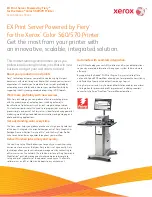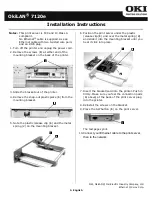
User Operations Guide—Mira Instant Replay Server
Revised: 5 September 2014
Copyright ©2014, Abekas Incorporated
71
For example, the “lead-in” may be an image of the world’s globe that zooms into view on the screen; then the globe is seen
seamlessly spinning around on its axis during the main body of the animation, and then upon a user’s command (clicking the
button) the entire globe zooms out of view, and off the screen.
Ping Pong
— any time the given clip is loaded into a play channel, the “
Ping Pong
” ( ) play repeat mode is turned ON by
default. With this flag enabled, when the clip is played from the starting point, the clip immediately seeks to the defined “
Play
Repeat IN
” timecode point within the clip, and continues to play forward to the “
Play Repeat OUT
” timecode point.
When this OUT point is reached, the clip automatically (and seamlessly) reverses direction and plays backward to the defined
“
Play Repeat IN
” point. The clip then plays forward from there again.
This cycle will repeat for as long as the clip is playing.
Ping Pong To
—
(
NOTE:
This flag is not yet implemented in current software; it will be activated in a future software update)
Any time the given clip is loaded into a play channel, the “
Ping Pong To
” play repeat mode is turned ON by default. With this flag
enabled, the clip can be played from the starting point through the defined “
Play Repeat IN
” timecode point within the clip, and
continues to play forward up to the “
Play Repeat OUT
” timecode point.
When this OUT point is reached, the clip automatically (and seamlessly) reverses play directions and plays backward to the “
Play
Repeat IN
” point. The clip then plays forward from there again.
This cycle will repeat as long as the clip is playing.
This “
Ping Pong To
” play repeat mode is typically used when playing animated graphics which have a “lead-in” portion at the
beginning of the clip, then has a cycling component somewhere within the middle of the clip; and upon a user command, will play
an “exit” animation on the trailing portion of the clip.
For example, the “lead-in” may be an image of an animated character that zooms into view on the screen; then the character is
seen seamlessly dancing back-and-forth during the main body of the animation, and then upon a user’s command (clicking the
button) the entire character zooms out of view, off the screen.
Play Repeat IN
— This timecode value determines the first frame (or field, depending upon the Output Mode flag) of the play
repeat cycling. The IN point defaults to the first physical frame of the clip. Click the mouse in this field and type a new timecode
value to define a new IN point.
The IN point is “inclusive” during play repeat playback, meaning this particular frame is included when playing the clip while play
repeat modes are active.
Play Repeat OUT
— This timecode value determines the last frame (or field, depending upon the Output Mode flag) of the play
repeat cycling. The OUT point defaults to one frame
beyond the last physical frame
of the clip. Click the mouse in this field and type
a new timecode value to define a new OUT point.
The OUT point is “exclusive” during play repeat playback, meaning this particular frame is NOT included when playing the clip while
play repeat modes are active.















































